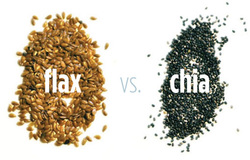
I use ground flaxseeds in my green smoothies to get my daily healthy omega-3 fatty acids, which are known to help reduce inflammation, prevent and control high blood pressure, and lower cholesterol. I ran out of ground flaxseeds this morning and I had some chia seeds on hand, which I know are also high in healthy omega-3 fatty acids, so I substituted the chia seeds for the flaxseeds. That got me wondering nutritionally, what’s the difference between flaxseeds and chia seeds. To figure that out, I went to the nutritional database – this time I used the SELFNutritionData website because I found it easier to get values for the omega-3 fatty acids.
I decided to compare the nutrition in one tablespoon of each since that’s the minimum suggested amount of flaxseeds or chia seeds to get the recommended daily allowance of healthy omega-3 fatty acids. Chia seeds were only reported in ounces or grams, so I weighed one tablespoon of chia seeds and used the weight to calculate the nutrients in one tablespoon of chia seeds for comparison.
While both flaxseeds and chia seeds are considered nutritionally superior foods, chia seeds have more of the healthy omega-3 fatty acids than flaxseeds (2.2 g and 1.6 g respectively). Chia seeds have significantly more fiber (4.7 g vs. 1.9 g), calcium (79.0 mg vs. 17.9 mg), and phosphorous (118.3 mg vs. 45.0 mg) as well as more calories (61.2 cal vs. 37.5 cal), protein (1.96 g vs. 1.28 g), and fat (3.84 g vs. 2.95 g). On the other hand, flaxseeds have more magnesium (27.5 mg vs. 0 mg), potassium (57 mg vs. 20 mg), and iron (0.4 mg vs. 0 mg).
Unlike flaxseeds, chia seeds can be eaten and absorbed whole, without being ground up. Plus, chia seeds do not require refrigeration. Nutrients from flaxseeds cannot be absorbed when eaten whole; the flaxseeds must be ground up in order for the nutrients to be absorbed. Once ground up, flaxseeds require refrigeration to retard oxidation which destroys the nutrients and turns ground flaxseeds rancid (whole flaxseeds can be stored for at least a year).
That said, while chia seeds have several advantages over flaxseeds, both are outstanding sources of the healthy omega-3 fatty acids and other nutrients!
I decided to compare the nutrition in one tablespoon of each since that’s the minimum suggested amount of flaxseeds or chia seeds to get the recommended daily allowance of healthy omega-3 fatty acids. Chia seeds were only reported in ounces or grams, so I weighed one tablespoon of chia seeds and used the weight to calculate the nutrients in one tablespoon of chia seeds for comparison.
While both flaxseeds and chia seeds are considered nutritionally superior foods, chia seeds have more of the healthy omega-3 fatty acids than flaxseeds (2.2 g and 1.6 g respectively). Chia seeds have significantly more fiber (4.7 g vs. 1.9 g), calcium (79.0 mg vs. 17.9 mg), and phosphorous (118.3 mg vs. 45.0 mg) as well as more calories (61.2 cal vs. 37.5 cal), protein (1.96 g vs. 1.28 g), and fat (3.84 g vs. 2.95 g). On the other hand, flaxseeds have more magnesium (27.5 mg vs. 0 mg), potassium (57 mg vs. 20 mg), and iron (0.4 mg vs. 0 mg).
Unlike flaxseeds, chia seeds can be eaten and absorbed whole, without being ground up. Plus, chia seeds do not require refrigeration. Nutrients from flaxseeds cannot be absorbed when eaten whole; the flaxseeds must be ground up in order for the nutrients to be absorbed. Once ground up, flaxseeds require refrigeration to retard oxidation which destroys the nutrients and turns ground flaxseeds rancid (whole flaxseeds can be stored for at least a year).
That said, while chia seeds have several advantages over flaxseeds, both are outstanding sources of the healthy omega-3 fatty acids and other nutrients!



 RSS Feed
RSS Feed